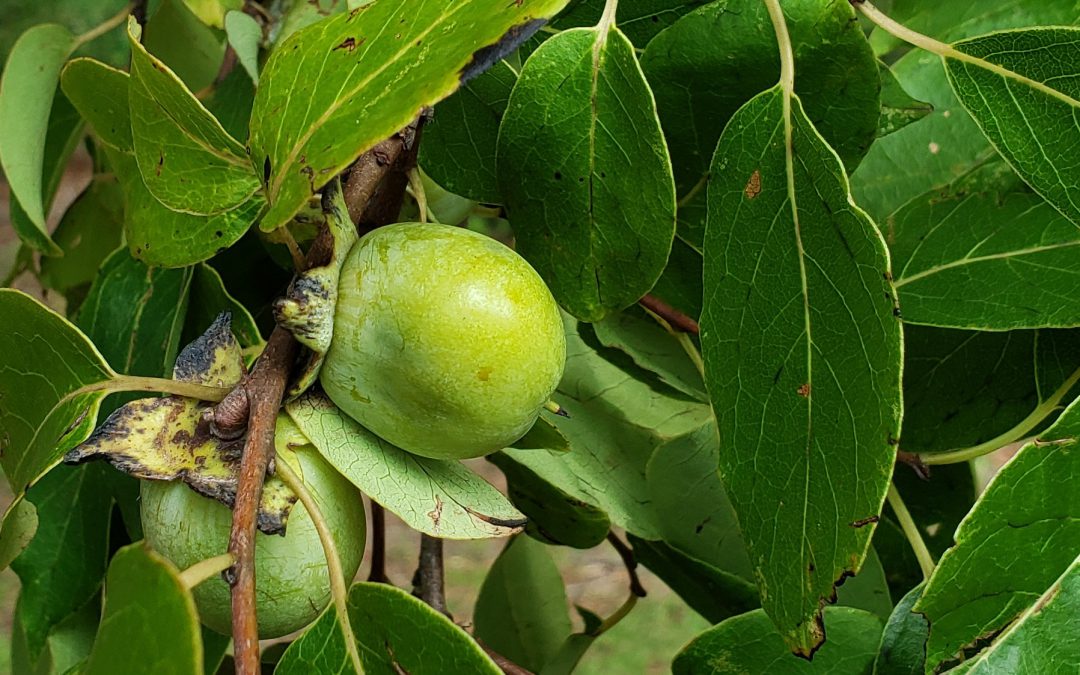
by Mark Mauldin | Oct 10, 2019
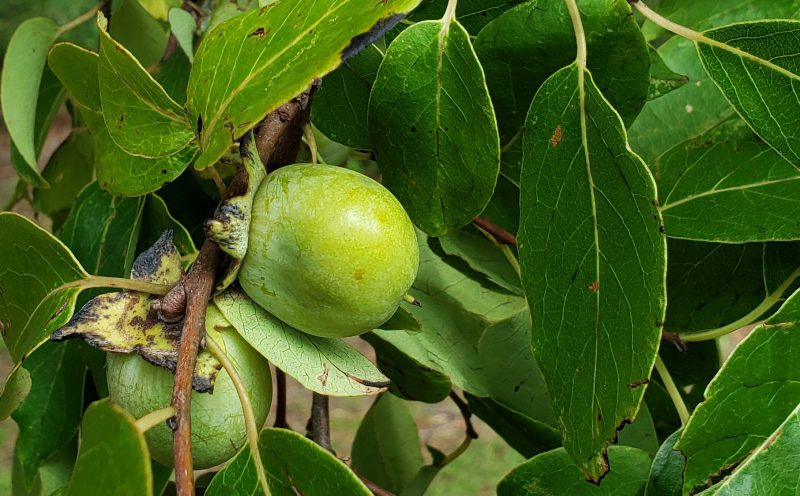
Protecting and promoting plants that produce soft mast, like this wild persimmon, can be a crucial step in improving wildlife habitat. Note: This time of year persimmons will be orange, the picture was taken earlier in the summer.
Photo Credit: Mark Mauldin
Landowners frequently prioritize wildlife abundance and diversity in their management goals. This is often related to a desired recreational activity (hunting, bird watching, etc.).
In order to successfully meet wildlife related management goals, landowners need to understand that animals frequent specific areas based largely on the quantity, quality and diversity of the food and cover resources available. Implementing management strategies that improve wildlife habitat will lead to greater wildlife abundance and diversity.
Herbivorous wildlife feed on plants, mostly in the form of forages and mast crops. All wildlife species have preferences in terms of habitat, especially food sources. Identifying these preferences and managing habitat to meet them will promote the abundance of the desired species.
Herbaceous plants, leaves, buds, etc. – serve as forages for many wildlife species. Promoting their growth and diversity is essential for improving wildlife habitat. Three common habitat management practices that promote forage growth include:
1) Create forest openings and edges; forested areas with multiple species and/or stand ages, areas left unforested allowing for increased herbaceous plant growth.
2) Thinning; open forest canopy allowing more light to hit the ground increasing herbaceous plant growth and diversity.
3) Prescribed fire; recycle nutrients, greatly improve the nutritional quality of herbage and browse, suppress woody understory growth.
Mast – the seeds and fruits of trees and shrubs – is often one of the most important wildlife food sources on a property.
Hard mast includes shelled seeds, like acorns and hickory nuts and is generally produced in the fall and serves as a wildlife food source during the winter.
Soft mast includes fruits, like blackberries and persimmons, and is generally produced in the warmer months, providing vital nutrition when wildlife species are reproducing and/or migrating.
Making management decisions that protect and promote mast producing trees will encourage wildlife populations.
Landowners can make supplemental plantings to increase the quantity and quality of the nutrition available to wildlife. These supplemental plantings (food plots/forage crops and mast producing trees) can be quite expensive and should be well planned to help maximize the return on investment.
Key points to remember to help ensure the success of supplemental wildlife plantings.
- Select species/varieties that are well adapted to the site.
- Take soil samples and make recommended soil amendments prior to planting.
- Make plantings in areas already frequented by wildlife (edges, openings, etc.).
- Food plots should be between 1 and 5 acres. Long, narrow designs that maximize proximity to cover are generally more effective.
Habitat management and other wildlife related topics are being featured this year in the UF/IFAS building at the Sunbelt Ag Expo. Make plans to attend “North America’s Premiere Farm Show” and stop by the UF/IFAS building, get some peanuts and orange juice and learn more about Florida’s Wildlife.
 If you have any questions about the topics mentioned above, contact your county’s UF/IFAS Extension Office or check out the additional articles listed on the page linked below.
If you have any questions about the topics mentioned above, contact your county’s UF/IFAS Extension Office or check out the additional articles listed on the page linked below.
EDIS – Wildlife Forages
A significant portion of this article was summarized from Establishing and Maintaining Wildlife Food Sources by Chris Demers et al.
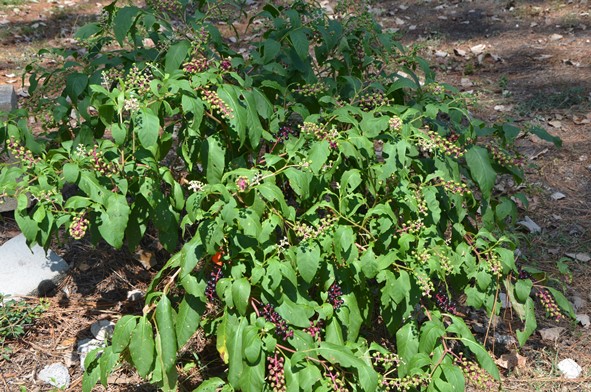
by Les Harrison | Sep 27, 2019

Pokeweed is currently producing many purple berries containing seed ready for avian distribution.
Half a century ago the AM airwaves included a tune by a rock singer who crooned about Polk Salad Annie. While not exactly epic lyrics, it did have a catchy beat which made it to number eight on Billboard’s Hot 100.
The basis of this dish was common pokeweed (Phytolacca americana), a native of North American perennial weed frequently found in pastures as well as fence-rows, fields, wooded areas and neglected residential landscapes.
The reason this plant is only on the menu of the economically distress is all parts of it contain saponins, oxalates, and the alkaloid toxin phytolacine. The roots and seeds of this species contain the highest concentrations of these compounds.
As winter moves to spring, this plant is emerging from its winter dormancy. The warm summer of 2019 has accelerated the regrowth in north Florida and the surrounding states.
Once pokeweed becomes established, it regrows each year from a large, fleshy taproot which penetrates over a foot deep. The crown of the root is where the plant is regenerated and can be as large as five and a half inches in diameter at the soil surface within two growing seasons.
Pokeweed usually has a red trunk like stem, which becomes hollow as the plant matures later in the year. Leaves become quite large as the plant grows to its full potential and are the basis for the Polk salad.
The process for rendering the leave edible by humans, or other mammals, involves boiling and washing with a second boiling and more washing. Short of eminent starvation, it is not a good or safe meal choice for dining.
When in bloom the individual flowers appear green to white and are typically missing petals. Fruits are green when immature and turn a deep purple to black at maturity which is the basis for one alternate name for this species, inkberry.
Each fruit contains about nine small, hard-shelled seeds. Pokeweed can produce a few thousand seeds to over 48,000 seeds per plant annually.
In the right situation these seeds may remain viable in the soil for over four decades (40 years). When exposed to favorable environmental conditions the seed sprout and the process is repeated.
While not a suitable selection for people or livestock, birds eat the fruits without much evidence of harm and are usually the means for seed dispersal. Roosting sites along fence rows and under utility lines frequently show signs of seed deposits.
In addition to feeding cardinals, mocking birds, cedar waxwings and other avian species, the pokeweed is host to a variety of insects. Some are beneficial and others are not.
A number of caterpillars utilize this weed to sustain their larval stage of development. Unfortunately, some other less desirable insects use the local weed, too.
Pokeweed can act as reservoirs of various viruses transmitted by insects which are destructive to vegetable and ornamental plants. Whiteflies and aphids are the main culprits, but other insect species can contribute the disease issue.
Old rock tunes aside, it is best to leave the pokeweed and Polk salad to the bugs and birds.
To learn more about pokeweed read the UF/IFAS publication COMMON POKEWEED.
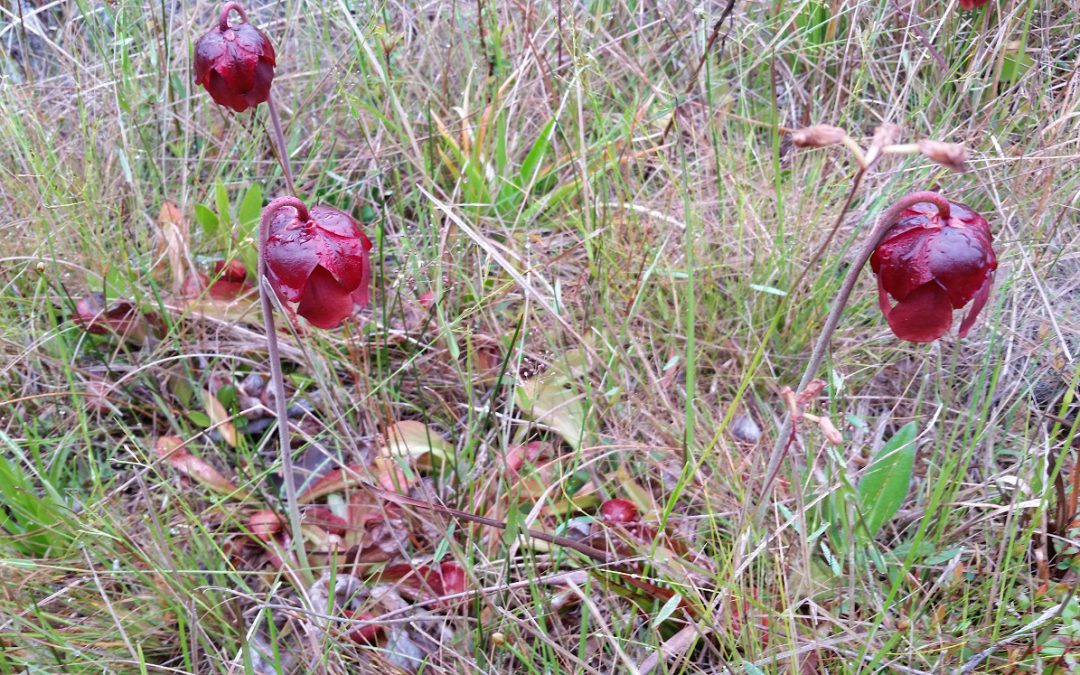
by Erik Lovestrand | May 31, 2019
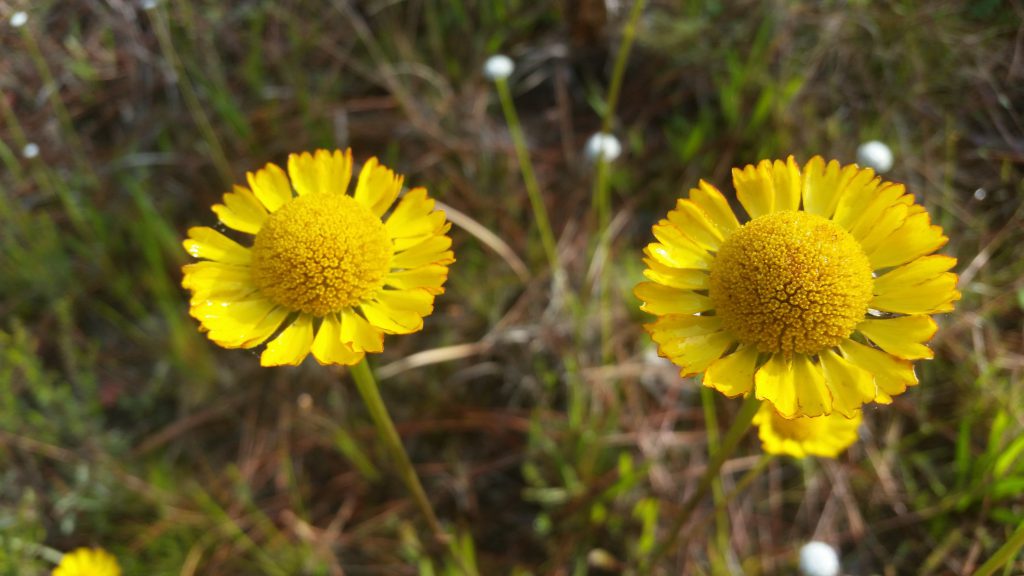
Yellow asters such as sneezeweed bloom profusely during summertime in the flatwoods.
Our coastal habitats are some of the most beautiful on the planet. Where else can you have the breathtaking, wide open vistas of our salt marshes, the incredible productivity of our nearshore bays, and the expansive pinelands in the adjacent uplands. Year-round opportunities abound to be outside and enjoy the natural resources we are blessed with. Just go prepared for the inevitable encounter with some of our bloodsucking flies and midges that are part of the package deal. A pair of binoculars, snacks, water and proper clothing provide the makings of a great day out, but I would also recommend a picture-taking device of some sort. I’ve basically given up on the heavier camera gear and the notion of getting long-distance close-ups. I now rely on my cell phone or a small digital camera; mainly for taking photos of flowers, bugs, and anything else that doesn’t require stealth and patience to shoot.
One of the best habitats to explore during this time of year for capturing memorable images is the upland pine flatwoods that is so abundant in the Florida Panhandle. There is no shortage of public lands that display some of the most well-managed pineland landscapes in the nation. Pineland ecosystems in the Southeast have been intimately linked with a natural fire regime, long before Europeans came on the scene. Successional cycles of increasing shrubby growth over time and the ability of the landscape to carry a fire after a lightning strike, have allowed these areas to develop with the “park-like” vista of a pine tree savanna in many cases. When fire is excluded by people, these ecosystems gradually convert to more hardwood species that tend to shade-out herbaceous growth on the ground and reduce the opportunity for new pine seedlings to become established. Professional land managers who work hard to mimic natural fire cycles on the lands they manage produce some astounding results. I can attest, as many of the areas where I hunt turkeys each spring are chosen more for the beauty of the landscape than the abundance of gobblers. Although fewer gobblers is not typically the ideal hunting scenario, the silver lining comes in the form of less competition with other hunters.
This spring I hunted in part of the St. Marks National Wildlife Refuge and had a nice mix of fairly recently burned pinelands to explore. Some were burned this spring, and was just starting to green-up with newly emerging grasses and forbs. Other areas were burned a year or two ago and you would never know it except for the charred bark on tree trunks. These areas recover to full greenery in a very short time. The foot-high wild blueberry bushes were loaded with green berries for summer wildlife feasts to come, and the photo opportunities for wildflowers abounded. Fire is so important in retaining a high species diversity in these habitats. Opening up the canopy allows sunlight to filter through to the forest floor and the recycling of nutrients in the ash supports many unique plants. There are several terrestrial orchids that bloom in the wetter soils (grass pink, colic root, lady’s tresses, etc.), and yellow flowers are prolific right now (St. John’s wort, sneeze weed, candy root and many more). I even saw some parrot pitcher plants in one wet spot, noticeable mainly by their tall maroon flowers. Fetterbush and staggerbush are also blooming with small flowers that look similar to blueberry blooms. The difference in scent of these two Lyonia shrubs is an easy way to tell them apart with fetterbush having a strong musky (not totally unpleasant) smell, while staggerbush (rusty Lyonia) has one of the sweetest, most pleasant smells of spring in the flatwoods.
So, while I did have the opportunity to chase around a gobbler this spring (who easily out-maneuvered me), I truly enjoyed my week of annual leave spent reconnecting with something that we too often take for granted. Take time to locate the state parks, national wildlife refuges, state forests and other public lands in your region. Then go outside. I mean it; none of us should miss the chance of a lifetime to see what we really have here.
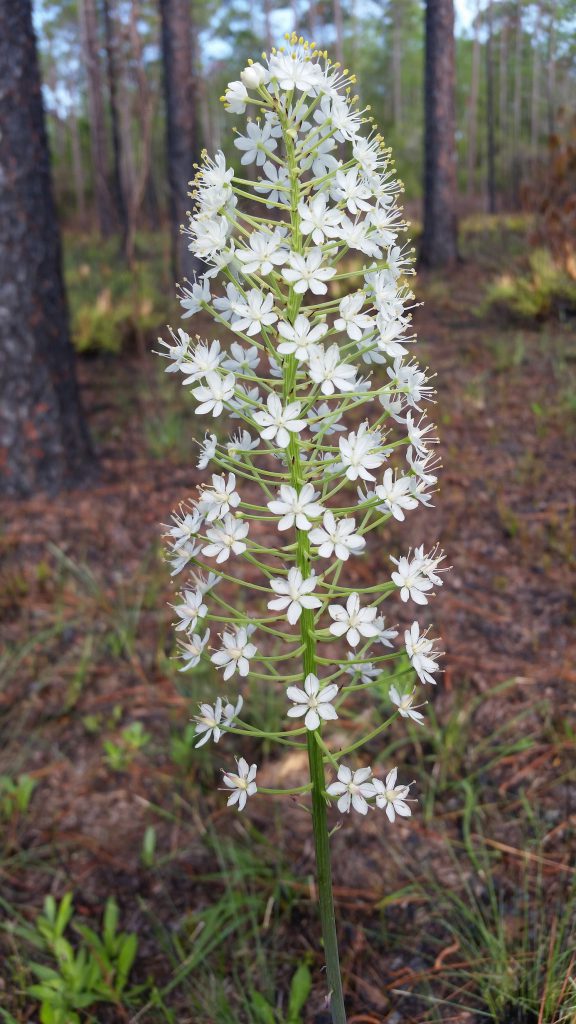
Crow poison, also know as Osceola’s plume shows up in wet flatwoods, most noticeably after a fire.
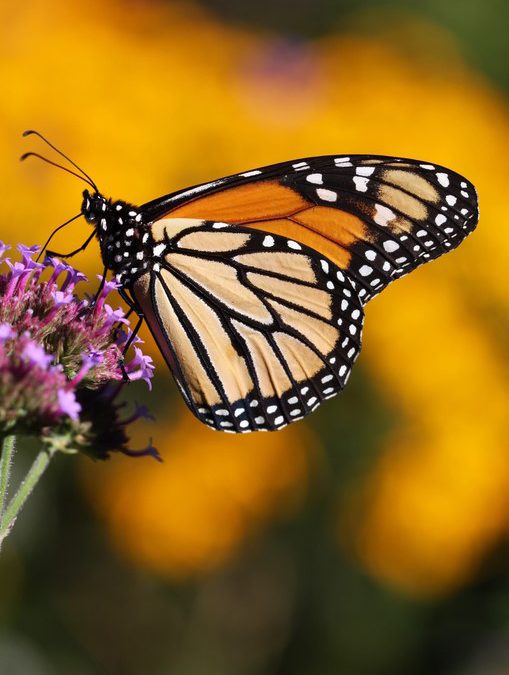
by Molly Jameson | Apr 18, 2019
With spring upon us, the mighty monarch butterflies have begun their long trek to the north from Mexico, looking to time their migration with growth of the milkweed plants in the southeastern United States. Mated monarch females lay hundreds of eggs along their journey, but only two percent of these eggs will survive to become mature caterpillars to carry on the next generation.
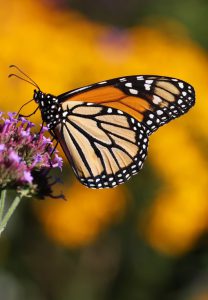
The monarch butterfly.
Photo: Steven Katovich USDA Forest Service
Monarch larvae rely exclusively on milkweed for nutrients, so it is of upmost importance that the plants are available to the offspring at the correct time. If the adult monarchs arrive too early, the milkweeds may not have had enough time to grow after late frosts. If they arrive too late, the milkweed vegetation may not support the nutrient needs of the caterpillars. In addition, the milkweeds contain a poisonous toxin, cardiac glycoside, that stays within the caterpillars’ bodies once consumed. This does not harm the larvae, but actually helps them, as it makes the young and adult butterflies taste terrible and makes them poisonous to potential predators.
For these reasons, it is important that we all do our part to support the growth of native milkweed species. Locally, the Monarch Milkweed Initiate at the St. Marks National Wildlife Refuge educates the public about milkweed and monarchs and grows and transplants native milkweed to support the monarchs on their migration.
When planting milkweed, be aware that there is a popular commercialized non-native tropical milkweed species that is not appropriate for the monarchs in our area. This species, Asclepias curassavica, can flower year-round, luring the monarchs to stay and breed in the winter when they should be on their way back to Mexico to escape freezing temperatures. Staying and breeding too long can make the monarchs susceptible to a protozoan parasite, Ophryocystis elektroscirrha (OE for short), that infects the caterpillars when feeding, reducing their lifespan, body mass, mating success rate, and ability to migrate.
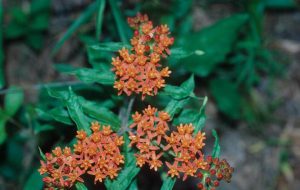
Butterfly milkweed (Asclepias tuberosa)
Photo: John Ruter, University of Georgia
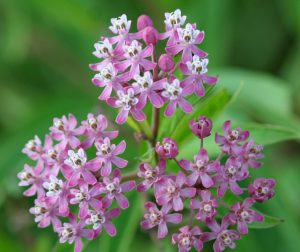
Swamp milkweed (Asclepias incarnata).
Photo: David Cappaert
Luckily, there are about 21 native milkweed species in Florida. Many native milkweeds in the Florida Panhandle require specialized care when grown for transplanting, as different species have adapted to a range of habitats. The Asclepias tuberosa, commonly referred to as butterflyweed, is considered easiest to grow as they transplant well and thrive in full sun. Others, such as Asclepias perennis, or aquatic milkweed, and Asclepias incarnata, swamp milkweed, must be grown using trays without drain holes, as their “feet” must be kept wet. The Asclepias humistrata, or sandhill milkweed, requires a drier, heavier soil.
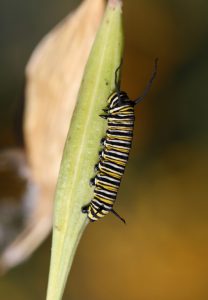
Monarch catepillar (Danaus plexippus).
Photo: Steven Katovich, USDA Forest Service
To support the monarchs and grow milkweed in your garden, come to the Leon County Extension Office at 615 Paul Russell Road on Saturday, May 11, from 9:00 a.m. to 1:00 p.m. for the Spring Open House and Plant Sale. Master Gardeners have been busy growing native milkweeds for this event and will be on hand selling the transplants. There will also be many other Florida Friendly and native plants available, along with guided garden tours, kids’ activities, the UF/IFAS Bookstore, a silent auction, live music by the Tallahassee Woodwind Quintet, refreshments, and Master Gardeners and Extension Agents on-hand to answer any of your gardening questions.
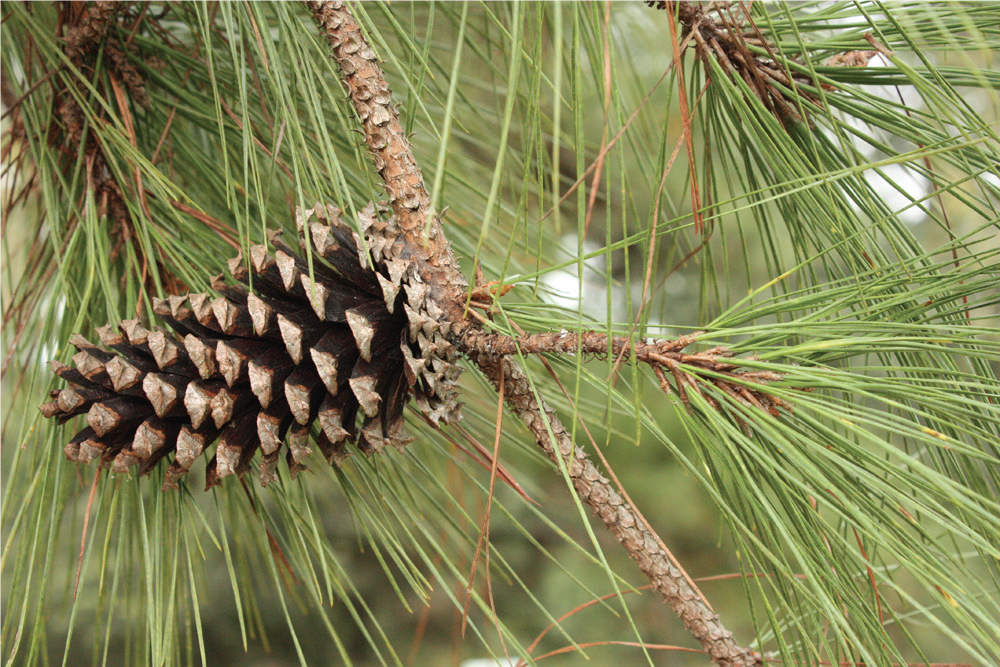
by Sheila Dunning | Apr 18, 2019

Young Longleaf Pine
All of Florida’s ecosystems contain pine trees. There are seven native species in the state; Sand, Slash, Spruce, Shortleaf, Loblolly, Longleaf, and Pond. Each species grows best in its particular environment. Pines are highly important to wildlife habitats as food and shelter. Several species are equally valuable to Florida’s economy. Slash, Loblolly, and Longleaf are cultivated and managed to provide useful products such as paper, industrial chemicals, and lumber. All pines are evergreens, meaning they keep foliage year-round. The leaves emerge from the axil of each scale leaf into long slender needles clustered together in bundles. Needles are produced at the growing tips of each branch and remain on the tree for several years before turning reddish-brown and falling off. The bundles are referred to as “fascicles”. The length and number of needles in each fascicle is one way to help identify the different pine species.
A handy rule of thumb is that pines starting with “S” have needles in twos, while pines starting with “L” have needles in threes. And slash pine, which starts with “SL” has needles in twos and threes. The pond pine is also a three-needled fascicle. Pay attention to their length and the number that are held in a fascicle. Because the numbers per fascicle may vary, be sure to check several fascicles to get an overall sense for the plant! Longleaf has the longest needle, measuring over 10 inches. While sand pine has the shortest needles at around 2 inches in length. Pine cones are also a means for identification. Typically the longer the needle, the bigger the cone. But, they also vary in attachment and “spinyness’.
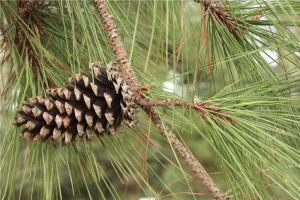
Cone of Loblolly Pine, attached directly to the stem
The outer (dorsal) surface of each seed cone scale has a diamond-shaped bulge, or “umbo,” formed by the first year’s growth. The umbo may or may not be armored with a “prickle,” a sharp point but not quite a spine or thorn, at the tip. As the seed cone continues to grow and expand, the exposed area at the end of each scale grows as well. The larger diamond-shaped area around the umbo, formed in the second year of growth, is called the “apophysis.” The shapes of the prickle, umbo, and apophysis can be helpful in identification. The male and female cones are separate structures, but both are present on the same plant. Pollen is produced by male cones and is carried by the wind to female cones where it fertilizes the ovules. Seeds develop and mature inside the female cones (also called the seed cones) for two years, protected by a series of tightly overlapping woody scales. Some pines open their seed cones after two years to release the seeds, while other pines continue to keep their cones tightly closed past maturity and release seeds in response to the heat of a forest fire.
To learn more about Florida’s pines and helpful hint on identification go to:
http://edis.ifas.ufl.edu/pdffiles/fr/fr00300.pdf
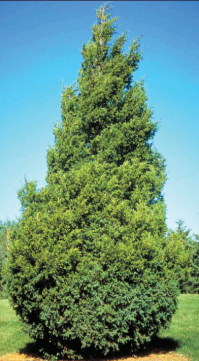
by Sheila Dunning | Dec 19, 2018
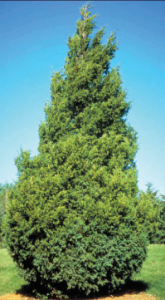 Throughout history the evergreen tree has been a symbol of life. “Not only green when summer’s here, but also when it’s cold and dreary” as the Christmas carol “O Tannenbaum” says. After such devastating tree losses in the Panhandle this year, this winter is a prime time for installing more native evergreens.
Throughout history the evergreen tree has been a symbol of life. “Not only green when summer’s here, but also when it’s cold and dreary” as the Christmas carol “O Tannenbaum” says. After such devastating tree losses in the Panhandle this year, this winter is a prime time for installing more native evergreens.
While supporting the cut Christmas tree industry does create jobs and puts money into local economics, every few years considering adding to the urban forest by purchasing a living tree. Native evergreen trees such as Redcedar make a nice Christmas tree that can be planted following the holidays. The dense growth and attractive foliage make Redcedar a favorite for windbreaks, screens and wildlife cover. The heavy berry production provides a favorite food source for migrating Cedar Waxwing birds. Its high salt-tolerance makes it ideal for coastal locations. Their natural pyramidal-shape creates the traditional Christmas tree form, but can be easily pruned as a street tree.
Two species, Juniperus virginiana and Juniperus silicicola are native to Northwest Florida. Many botanists do not separate the two, but as they mature, Juniperus silicicola takes on a softer, more informal look. For those interested in creating a different look, maybe a Holly (Ilex,sp.) or Magnolia with full-to-the-ground branches could be your Christmas tree.
When planning for using a live Christmas tree there are a few things to consider. The tree needs sunlight, so restrict its inside time to less than a week. Make sure there is a catch basin for water under the tree, but never allow water to remain in the tray and don’t add fertilizer. Locate your tree in the coolest part of the room and away from heating ducts and fireplaces. After Christmas, install the new tree in an open, sunny part of the yard. After a few years you will be able to admire the living fence with all the wonderful memories of many years of holiday celebrations. Don’t forget to watch for the Cedar Waxwings in the Redcedar.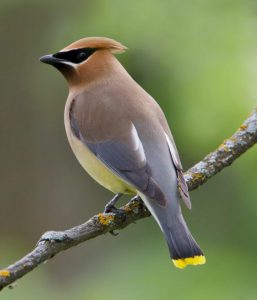


 If you have any questions about the topics mentioned above, contact your county’s UF/IFAS Extension Office or check out the additional articles listed on the page linked below.
If you have any questions about the topics mentioned above, contact your county’s UF/IFAS Extension Office or check out the additional articles listed on the page linked below.














